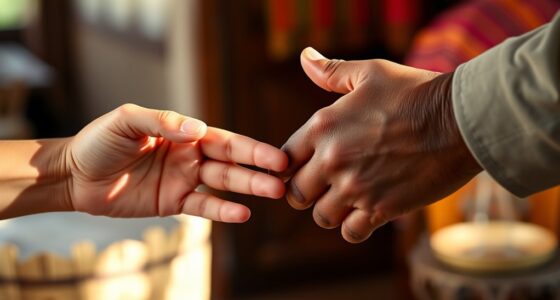“Mano Po” symbolizes deep respect and gratitude in Filipino relationships. It’s a gesture where you bow and touch an elder’s hand to your forehead, acknowledging their wisdom. This practice strengthens family bonds and emphasizes inter-generational connections. Rooted in cultural traditions, it adapts to modern life while preserving core values of respect and love. Understanding this gesture enriches your appreciation for Filipino culture and relationships. Keep exploring to uncover more about its significance and impact.
Key Takeaways
- “Mano Po” reinforces respect for elders, strengthening familial bonds across generations in Filipino culture.
- The gesture symbolizes gratitude for the wisdom shared by older family members, enhancing emotional connections.
- It promotes family cohesion and unity, embodying core Filipino values of respect and submission.
- “Mano Po” adapts to modern life while preserving cultural identity, ensuring its relevance today.
- This practice fosters inter-generational bonding, reminding individuals of their cultural heritage and the importance of honoring ancestors.
Cultural Tradition and Heritage of “Mano Po”

The tradition of “Mano Po” serves as an essential link between generations in Filipino culture. It traces its roots back to indigenous practices that honored elders, intertwining with European customs during Spanish colonization. This blend reflects a rich cultural heritage shaped by both local and foreign influences. By practicing “Mano Po,” you demonstrate deep respect and gratitude towards the wisdom of your elders, showcasing humility and reverence. This gesture not only strengthens familial bonds but also fosters community unity, bridging gaps between generations. As you embrace this enduring tradition, you help preserve cultural practices, ensuring they remain significant in modern Filipino life. “Mano Po” symbolizes the values that define your identity and heritage, promoting respect for elders in homes and communities alike.
Performative Aspects of the Gesture
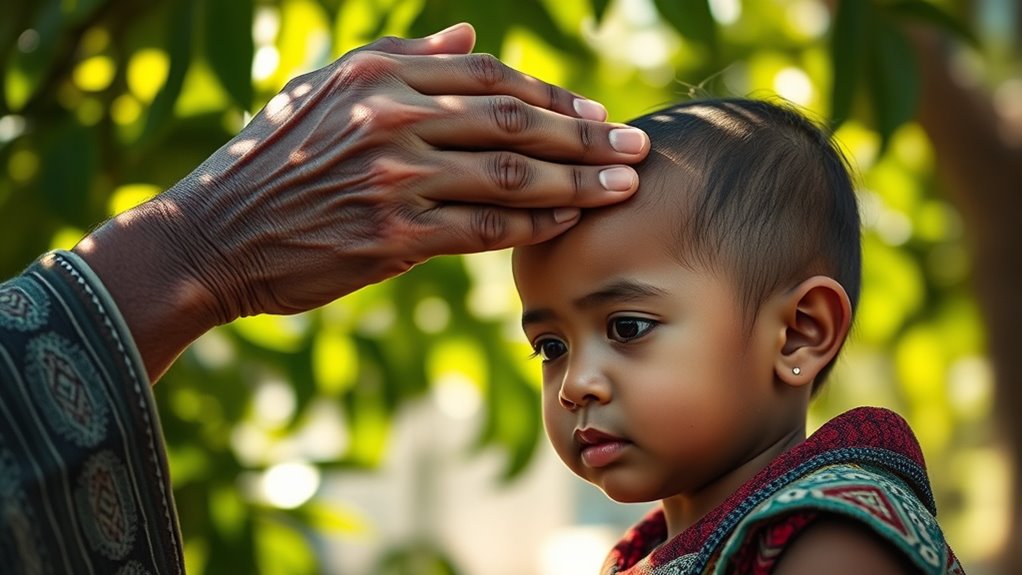
In Filipino culture, the act of performing “Mano Po” carries significant weight beyond its cultural heritage. When you bow toward an elder and press your forehead against their hand, you’re acknowledging their wisdom and seeking their blessing. This gesture, typically made with your right hand, symbolizes respect and submissiveness to their authority. Traditionally, you’d say “Mano po” aloud, although younger generations sometimes skip this verbal component. You perform this gesture upon entering an elder’s home or during family gatherings, making it essential in appropriate contexts. “Mano Po” reflects your respect for elders and embodies core Filipino values, emphasizing intergenerational connections and cultural identity, ensuring that these cherished traditions continue to thrive. It also serves as an opportunity for mending relationships, fostering forgiveness and understanding among family members.
Strengthening Family Bonds Through “Mano Po”
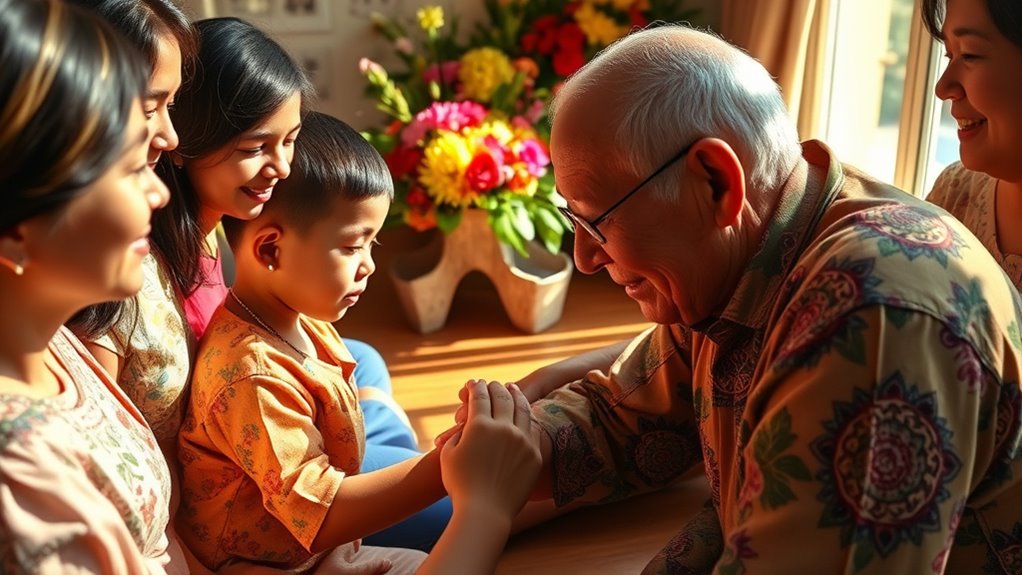
While you may not realize it, performing “Mano Po” can considerably strengthen family bonds within Filipino culture. This simple gesture reinforces respect for elders, a core value that fosters unity across generations.
By showing deference and seeking blessings, you’re not just honoring your elders but also emphasizing family cohesion and solidarity. “Mano Po” symbolizes love and gratitude, allowing you to express appreciation for the wisdom shared by older family members.
It nurtures emotional connections and promotes harmony, ensuring that respect flows through the family hierarchy. Even as society evolves, this timeless tradition remains essential, adapting to modern life while preserving cultural identity.
Ultimately, “Mano Po” serves as a bridge, connecting you with your family’s heritage and values.
Historical Origins and Evolution of the Practice
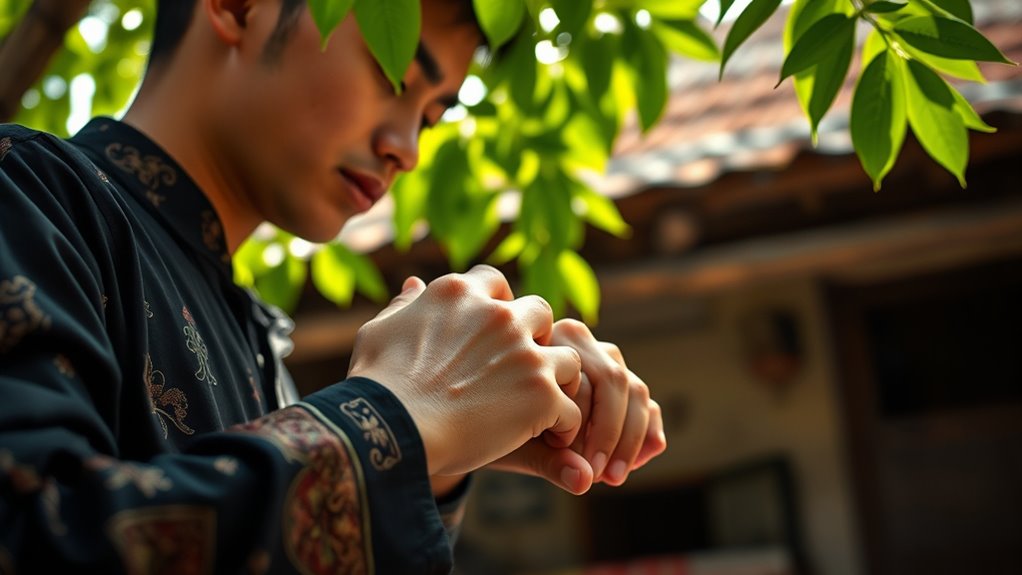
Understanding the significance of “mano po” goes beyond its role in strengthening family bonds; it also reveals a rich historical tapestry woven from diverse cultural influences.
The term “mano,” derived from Spanish meaning “hand,” and “po,” a marker of respect, highlights the blending of cultures in the Philippines. This gesture likely originates from Spanish hand-kissing customs, merging with pre-colonial practices that honored elders.
Over centuries, Filipinos uniquely adapted “mano po,” asking for blessings during significant occasions. Despite modernization, it remains an essential expression of Filipino identity, showcasing cultural resilience.
You can see how “mano po” embodies respect, illustrating the importance of tradition in contemporary society while maintaining deep-rooted familial values.
Social Impact and Etiquette in Filipino Communities
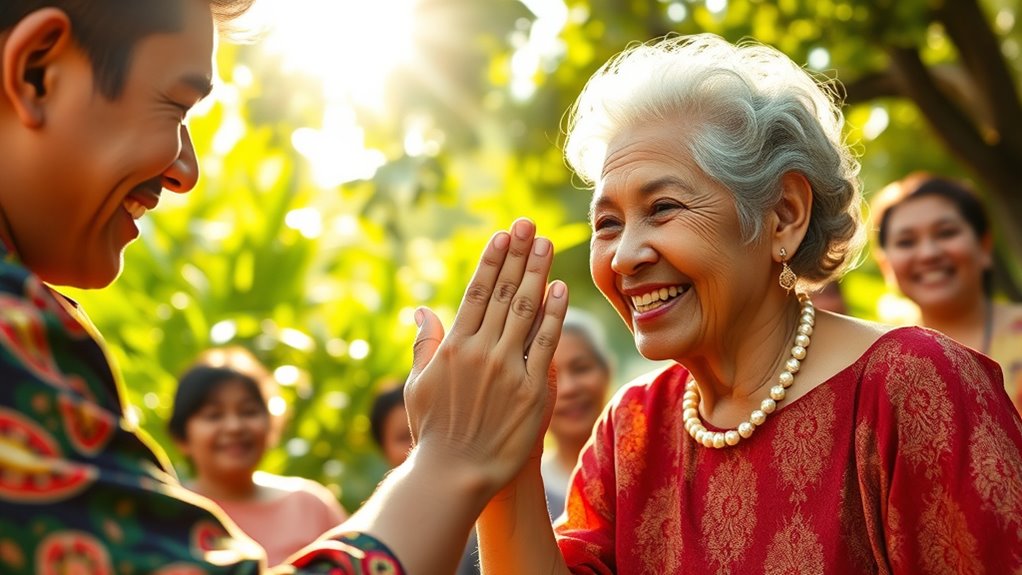
As you explore Filipino communities, you’ll quickly notice how “mano po” plays a crucial role in shaping social dynamics and etiquette. This gesture emphasizes respect for elders, fostering family unity and reinforcing cultural identity.
You’ll see it practiced during family gatherings, weddings, and religious celebrations, both in formal and informal settings. Remember, when entering an elder’s home or greeting them, performing “mano po” is essential; failing to do so is considered impolite.
Elders often respond with blessings, further enhancing interpersonal relationships. By acknowledging the wisdom of elders, “mano po” strengthens community bonds and teaches younger generations about humility and respect.
It remains an important tradition, preserving cultural heritage while promoting social coherence in Filipino life.
Modern Relevance and Adaptation of “Mano Po”

The enduring practice of “mano po” showcases its modern relevance in Filipino culture, where it continues to symbolize respect and reverence for elders.
Despite urbanization and globalization, you’ll find that this tradition remains a cherished part of family gatherings, whether formal or informal. It highlights the importance of inter-generational bonding, as you seek blessings and good wishes from your elders, reinforcing family ties.
The symbolism of respect, gratitude, and humility stays strong, even as the phrase may sometimes be omitted in modern contexts. “Mano po” adapts seamlessly into contemporary life while preserving its essence, serving as a reminder of your cultural identity and the value of honoring those who came before you.
Teaching Respect and Values to Future Generations
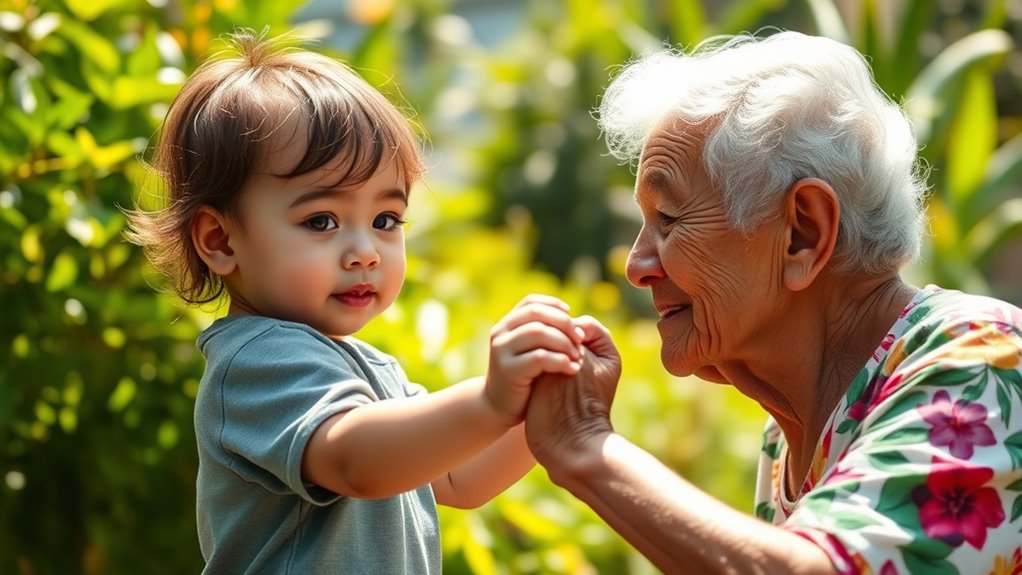
While many traditions may fade over time, teaching respect and values through the practice of “mano po” remains essential in Filipino culture. This gesture not only honors elders but also strengthens family bonds, emphasizing the importance of respect and gratitude.
By practicing “mano po,” you help transmit cultural values like humility and intergenerational connections. It reinforces social norms that prioritize respect for elders, making it a fundamental part of life.
As you engage in this tradition, you model respect and create a sense of cultural pride in younger generations. Ultimately, “mano po” fosters unity, ensuring that the values and traditions of Filipino culture continue to thrive for future generations.
“Mano Po” as a Symbol of Filipino Identity Globally
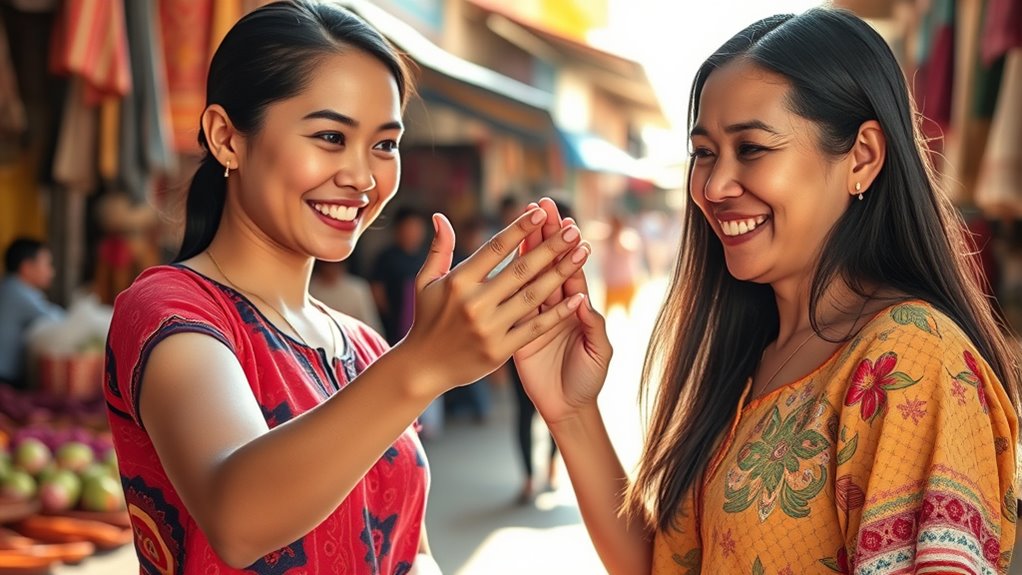
Though many cultures have their own ways of showing respect, “mano po” stands out as a powerful symbol of Filipino identity worldwide. This gesture embodies respect, loyalty, and humility, highlighting the importance of honoring elders and their wisdom.
As you travel or interact with others, you’ll find that “mano po” serves as a cultural ambassador, representing Filipino values on a global stage. It strengthens intergenerational bonds, fosters community unity, and connects younger generations to their cultural heritage.
Despite modernization, “mano po” remains cherished in formal and informal settings alike. Its recognition internationally showcases the enduring significance of respect in Filipino culture, making it a unique and timeless tradition that you can proudly share with the world.
Frequently Asked Questions
Can “Mano Po” Be Performed by Non-Filipinos?
Yes, you can perform “mano po” as a non-Filipino. It’s a respectful gesture, especially when interacting with Filipino elders.
Just make sure you understand its cultural significance to avoid any misunderstandings. When you perform it thoughtfully, you show appreciation for Filipino customs and build connections.
Most locals will appreciate your effort to engage with their traditions, so don’t hesitate to practice this beautiful gesture of respect.
Are There Alternative Gestures for Showing Respect in Filipino Culture?
Yes, there are several alternative gestures for showing respect in Filipino culture.
You can lower your head and extend your arms when passing by someone, or simply nod and smile as a casual greeting.
Another option is “beso-beso,” a cheek-to-cheek greeting among friends.
If you need to excuse yourself, saying “makikiraan po” while bowing is polite.
These gestures help you convey respect and warmth within the community.
How Do Younger Filipinos View “Mano Po” Today?
As you watch a child gently grasp an elder’s hand, bringing it to their forehead, you sense the warmth of tradition.
Today, younger Filipinos often see “mano po” as a cherished ritual, blending modernity with respect. While some may find it old-fashioned, many embrace it, recognizing its beauty in nurturing familial bonds.
You realize it’s not just a gesture; it’s a bridge connecting generations, embodying gratitude and love in a fast-paced world.
What Occasions Are Most Appropriate for Performing “Mano Po”?
You’ll find that “mano po” is most appropriate during family gatherings, when entering an elder’s home, or during your first encounter of the day with an elder.
It’s also common at cultural festivals and religious events. These occasions highlight respect and gratitude, allowing you to connect with your elders.
Are There Regional Variations of “Mano Po” in the Philippines?
Did you know that over 100 ethnic groups populate the Philippines, each with unique customs?
When it comes to “mano po,” you’ll find slight regional variations in how it’s performed. In some areas, you might see a more formal approach, while others embrace a casual execution.
The phrasing and context can differ too, adapting to local customs. Despite these nuances, the core gesture remains a heartfelt sign of respect throughout the nation.
Conclusion
In closing, embracing “mano po” enriches your connections, honors your elders, and celebrates your heritage. By practicing this gesture, you’re not just showing respect; you’re weaving together tradition and modernity, strengthening family ties and fostering community. As you teach the next generation, you’re nurturing values of respect and love, ensuring that the spirit of “mano po” continues to thrive. Remember, it’s more than a gesture; it’s a profound symbol of your Filipino identity, both at home and abroad.


